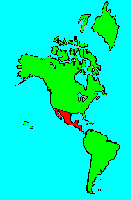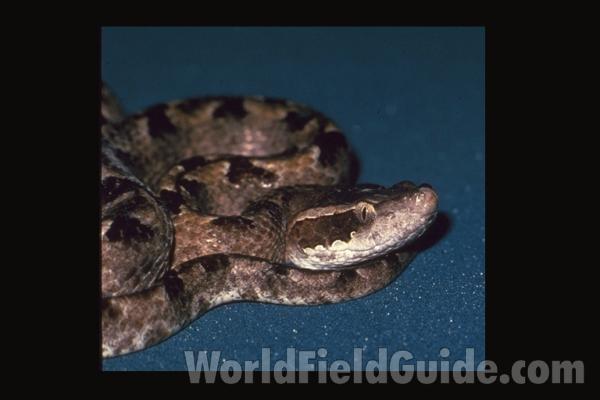SPECIES INFO
Fer-de-Lance (Bothrops atrox asper or perhaps Bothrops andianus asper) is one of the most feared snakes in South and Central America. There is considerable argument as to the precise taxonomic treatment of this group of very dangerous snakes. Although most adult specimens are about four feet long, examples over eight feet can be found.Lance heads and fer-de-lance genus (Bothrops) can be found from Mexico south into Argentina. There are about 32 species of snakes in this genus, several of which are very dangerous.
New World Viperidae (exclusive of the rattlesnakes) are represented in North America by the Water Moccasin (Cottonmouth) and the Copperhead.
Vipers (Family Viperidae) are an almost worldwide group of poisonous snakes with excellent striking ability. They open their mouths very wide when striking and their hollow fangs can penetrate deeply to permit large amounts of venom to be deposited. Any bite should be considered very serious and should get immediate medical attention. Many of the species have very deadly venom.
Included in this group are the rattlesnakes, copperhead, and water moccasins of the New World. Also included in this family are the Old World adders and vipers. There are about 230 species in the Viperidae family. This family can be further divided into subfamilies. The two best known sub-families are the Old World Vipers (wo pits) (Viperinae) and the Pit vipers (Crotalinae).
Lizards and Snakes (Squamata Order) share many common characteristics and consequently they are grouped in a single order. There are greater differences between some groups of lizards than there are between other groups of lizards and snakes. The same is true of snakes. Lizards and snakes share a common skull shape.
There are perhaps 4,000 species of lizards and perhaps 2,700 species of snakes alive today. In the Great Big Book of Snakes and Reptiles published in 2014, they noted the above estimates.
Reptiles (Class Reptilia) are an ancient group of scaled chordates. These scales may be permanently joined, as in the turtles, or flexible, as in the snakes. Reptiles are land-based. Their eggs are laid on land and the young are air breathing.
In the Great Big Book of Snakes and Reptiles published in 2014, they noted that there are more than 7,000 species of reptiles alive today.
Backboned Animals (Phylum Chordata) are the most advanced group of animals on earth. These animals are characterized by having a spinal cord or backbone. Most members have a clearly defined brain that controls the organism through a spinal cord. Fish, amphibians, reptiles, birds, and mammals are in this phylum.
Currently, some taxonomists believe that the fish should be divided into two groups (sharks and regular fishes) and that there are some other primitive groups in the phylum such as hagfish or lampreys.
Animal Kingdom contains numerous organisms that feed on other animals or plants. Included in the animal kingdom are the lower marine invertebrates such as sponges and corals, the jointed legged animals such as insects and spiders, and the backboned animals such as fish, amphibians, reptiles, birds, and mammals.




